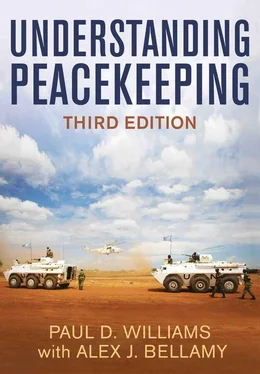Although the UN received much of the blame for what happened in Angola, Somalia, Bosnia and Rwanda – some of it rightly – its member states played crucial roles. It was member states, not the UN Secretariat, that crafted mandates and determined resources. Moreover, the bungled ‘Blackhawk Down’ operation in Mogadishu in October 1993 that marked the beginning of the end of UNOSOM II was conducted by US soldiers (not UN peacekeepers); the DPKO had warned the Security Council that without adequate resources the so-called safe areas in Bosnia would be vulnerable to attack; and the decision to stand aside during Rwanda’s genocide in 1994 was taken against the advice of the UN’s force commander on the ground. Nevertheless, it was these four missions that provide the crucial context for understanding the retreat from UN peace operations in the late 1990s.
The first signs of major UN failure came in Angola in 1992. Following UNAVEM I’s success in overseeing the withdrawal of Cuban forces, in May 1991 the Security Council established UNAVEM II to oversee the demobilization of ex-combatants and monitor national elections. To accomplish this task, the mission was afforded 350 military observers and 400 civilian election observers (Anstee 1996; Howard 2008: 37). Earlier missions of this size, such as UNGOMAP, UNAVEM I, UNIIMOG and ONUCA, had succeeded primarily because the belligerents were themselves deeply committed to the peace process. This was not the case in Angola, and UNAVEM II lacked the capacity to operate without high levels of cooperation. Although it succeeded in creating an efficient monitoring and verification system (Fortna 1993: 402), UNITA rebels and the Angolan government used the lull in fighting to regroup and rearm rather than disarm and demobilize. When in September 1992 UNITA’s leader, Jonas Savimbi, lost national elections by a clear margin, he declared them fraudulent. Fighting broke out the following month, most likely initiated by the government (Lodico 1996: 121). Having failed to disarm the belligerents before the election and unable to influence events afterwards, UNAVEM II was forced to stand aside as the fighting claimed the lives of up to 300,000 people. In what was the most intense fighting of the decades-long civil war, Boutros-Ghali (1993: 5) reported in September 1993 that a thousand people were being killed each day. Diplomats from the US, Portugal and Russia attempted to broker new agreements, while UNAVEM II soldiered on amid the violence. In early 1995, the parties reached a new ceasefire agreement, and UNAVEM II was replaced by a much larger mission – UNAVEM III.
UNAVEM III was given a broad and ambitious mandate, including monitoring the ceasefire and verifying the withdrawal of combatants, cantoning, disarming and demobilizing combatants, collecting UNITA arms, verifying the movement of government troops, establishing a new national army, clearing mines, coordinating humanitarian activity and overseeing the presidential election. To accomplish this it was provided with 7,000 troops and around 750 civilians (Howard 2008: 39). Once again Savimbi refused to cooperate, first by not cantoning his forces and then by holding back his specialist force from cantonment and refusing to surrender weapons. UNAVEM III lacked both the military capability to disarm UNITA forcibly and the civilian capability to assist the government in building state capacity in UNITA-held territory. Thus, when UNAVEM III was wound up on schedule in 1997, it had not come close to completing its mandated tasks. There were, it should be said, some successes. Around 70,000 UNITA soldiers were disarmed and 11,000 were integrated into the national army, humanitarian coordination was improved and shaky coalition government was established (ibid.: 39–40). In the same year, however, UNITA demonstrated its military capacity by intervening in Zaire/DRC in support of Mobutu Sese Seko (Jett 1999: 167) and a year later Angola was plunged back into civil war.
UNAVEM II was the first of the UN’s 1990s missions to lack the capacity and mandate to hold a peace together in the face of resistance from belligerents. The mission was unprepared to prevent post-election violence from descending into all-out civil war. The loss of life was probably higher than that of the whole Bosnian war, and its successor, UNAVEM III, failed to disarm UNITA and prevent the war reigniting in 1998. The failure of UNAVEM II comprised elements typical of later disasters in Somalia, Bosnia and Rwanda: peacekeepers given ambitious tasks without the mandate, resources or political will necessary to fulfil them and sent into an environment where the consent and cooperation of belligerents was shaky at best. Given all this, it is perhaps surprising that the outbreak of violence in 1992–3 did not produce an international outcry and that Angola is not typically listed as one of the UN’s ‘great peacekeeping failures’ of the 1990s. This was because UNAVEM II did not attract international media attention and the Security Council’s engagement with Angola during this period was characterized by ambivalence (Howard 2008: 37; Lodico 1996: 123).
The same cannot be said about the international mission deployed to Somalia less than two months after Angola’s descent into violence. The US experience in Somalia marked the beginning of the world’s (temporary) disengagement from UN peace operations. In January 1991, the so-called United Somali Congress – a loose coalition led by Mohammed Farah Aidid and Ali Mahdi – drove the government of Siad Barre out of the capital, Mogadishu. Soon afterwards, the former allies turned on each other and Somalia descended into anarchy. Attacks on the civilian population and the destruction of food sources compounded droughts and caused a massive famine that killed up to 350,000 people in 1992 (Wheeler 2000: 174; Weiss 1999: 78). Although international actors belatedly responded by despatching large amounts of emergency aid, without armed protection a significant proportion of it was looted and thus failed to reach the intended civilian recipients. In response, the US deployed over 30,000 soldiers in December 1992 to help secure the delivery of aid and assist UN peacekeepers.
Relations between the US, the UN and various Somali leaders were strained, especially when the peacekeeping mandate was enlarged to include the disarmament of armed militia in addition to securing the delivery of humanitarian relief. On 5 June 1993, militia loyal to Mohammed Aidid killed more than twenty Pakistani peacekeepers who were inspecting a weapons dump as part of the disarmament process. In the face of such a serious challenge to the credibility of UN peace operations around the world, within days the Security Council issued Resolution 837, which authorized the use of force against those responsible for the attack. The United States’ troops in Somalia thus became preoccupied with bringing Aidid to justice. Throughout the summer of 1993 the US conducted numerous combat operations against his supporters, killing hundreds of belligerents and Somali civilians. Matters came to a head on 3 October, when US troops raided what they thought was a gathering of tribal elders sympathetic to Aidid at the Olympic Hotel. Over 500 Somalis, eighteen Americans and a UN peacekeeper were killed in the ensuing battle. Shortly afterwards, President Clinton announced that all American troops would be withdrawn within six months (Hirsch and Oakley 1995; Lyons and Samatar 1995; Clarke and Herbst 1997).
The White House also adopted a much tougher line on peace operations, announced by President Clinton at the 1993 General Assembly (see box 4.4). As the then US ambassador to the UN, Madeleine Albright, put it at the time: ‘we are coming to the day when countries in need will call the global 911 and get a busy signal’ ( The Times , 13 May 1993). The administration’s thinking was later codified in Presidential Decision Directive 25 (May 1994). This identified failings in the UN itself as the main reason for the US failure in Somalia and outlined seventeen conditions that would have to be met before the US would take part in a UN operation (Weiss 1997: 223). Since then the US has placed troop contingents under UN command as part of only one mission – the preventive mission in Macedonia (UNPREDEP; see chapter 6). As it turned out, the country in need of the global 911 that got no response would be Rwanda.
Читать дальше












